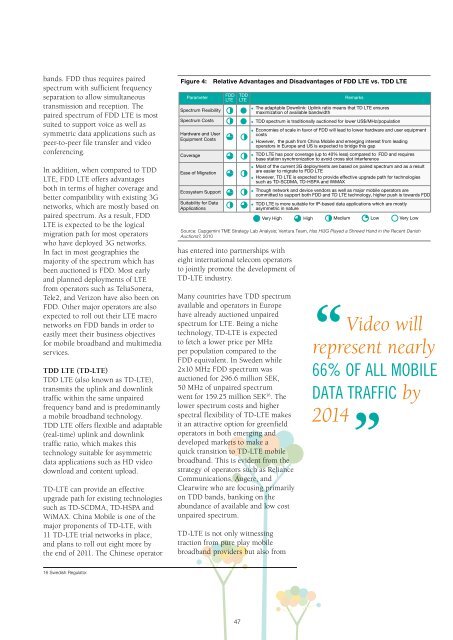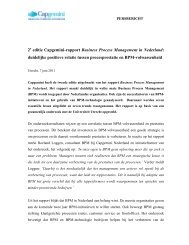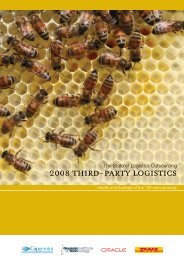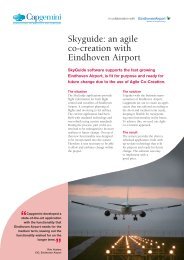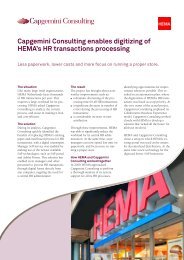IT transformations - Capgemini Consulting Nederland
IT transformations - Capgemini Consulting Nederland
IT transformations - Capgemini Consulting Nederland
Create successful ePaper yourself
Turn your PDF publications into a flip-book with our unique Google optimized e-Paper software.
ands. FDD thus requires paired<br />
spectrum with sufficient frequency<br />
separation to allow simultaneous<br />
transmission and reception. The<br />
paired spectrum of FDD LTE is most<br />
suited to support voice as well as<br />
symmetric data applications such as<br />
peer-to-peer file transfer and video<br />
conferencing.<br />
In addition, when compared to TDD<br />
LTE, FDD LTE offers advantages<br />
both in terms of higher coverage and<br />
better compatibility with existing 3G<br />
networks, which are mostly based on<br />
paired spectrum. As a result, FDD<br />
LTE is expected to be the logical<br />
migration path for most operators<br />
who have deployed 3G networks.<br />
In fact in most geographies the<br />
majority of the spectrum which has<br />
been auctioned is FDD. Most early<br />
and planned deployments of LTE<br />
from operators such as TeliaSonera,<br />
Tele2, and Verizon have also been on<br />
FDD. Other major operators are also<br />
expected to roll out their LTE macro<br />
networks on FDD bands in order to<br />
easily meet their business objectives<br />
for mobile broadband and multimedia<br />
services.<br />
TDD LTE (TD-LTE)<br />
TDD LTE (also known as TD-LTE),<br />
transmits the uplink and downlink<br />
traffic within the same unpaired<br />
frequency band and is predominantly<br />
a mobile broadband technology.<br />
TDD LTE offers flexible and adaptable<br />
(real-time) uplink and downlink<br />
traffic ratio, which makes this<br />
technology suitable for asymmetric<br />
data applications such as HD video<br />
download and content upload.<br />
TD-LTE can provide an effective<br />
upgrade path for existing technologies<br />
such as TD-SCDMA, TD-HSPA and<br />
WiMAX. China Mobile is one of the<br />
major proponents of TD-LTE, with<br />
11 TD-LTE trial networks in place,<br />
and plans to roll out eight more by<br />
the end of 2011. The Chinese operator<br />
Figure 4:<br />
Parameter<br />
Spectrum Flexibility<br />
Spectrum Costs<br />
Hardware and User<br />
Equipment Costs<br />
Coverage<br />
Ease of Migration<br />
Ecosystem Support<br />
Suitability for Data<br />
Applications<br />
Relative Advantages and Disadvantages of FDD LTE vs. TDD LTE<br />
FDD<br />
LTE<br />
TDD<br />
LTE<br />
Remarks<br />
■ The adaptable Downlink: Uplink ratio means that TD LTE ensures<br />
maximization of available bandwidth<br />
■ TDD spectrum is traditionally auctioned for lower US$/MHz/population<br />
■ Economies of scale in favor of FDD will lead to lower hardware and user equipment<br />
costs<br />
■ However, the push from China Mobile and emerging interest from leading<br />
operators in Europe and US is expected to bridge this gap<br />
■ TDD LTE has poor coverage (up to 40% less) compared to FDD and requires<br />
base station synchronization to avoid cross slot interference<br />
■ Most of the current 3G deployments are based on paired spectrum and as a result<br />
are easier to migrate to FDD LTE<br />
■ However, TD LTE is expected to provide effective upgrade path for technologies<br />
such as TD-SCDMA, TD-HSPA and WiMAX<br />
■ Though network and device vendors as well as major mobile operators are<br />
committed to support both FDD and TD LTE technology, higher push is towards FDD<br />
■ TDD LTE is more suitable for IP-based data applications which are mostly<br />
asymmetric in nature<br />
Very High High Medium Low Very Low<br />
Source: <strong>Capgemini</strong> TME Strategy Lab Analysis; Ventura Team, Has Hi3G Played a Shrewd Hand in the Recent Danish<br />
Auctions?, 2010<br />
has entered into partnerships with<br />
eight international telecom operators<br />
to jointly promote the development of<br />
TD-LTE industry.<br />
Many countries have TDD spectrum<br />
available and operators in Europe<br />
have already auctioned unpaired<br />
spectrum for LTE. Being a niche<br />
technology, TD-LTE is expected<br />
to fetch a lower price per MHz<br />
per population compared to the<br />
FDD equivalent. In Sweden while<br />
2x10 MHz FDD spectrum was<br />
auctioned for 296.6 million SEK,<br />
50 MHz of unpaired spectrum<br />
went for 159.25 million SEK 16 . The<br />
lower spectrum costs and higher<br />
spectral flexibility of TD-LTE makes<br />
it an attractive option for greenfield<br />
operators in both emerging and<br />
developed markets to make a<br />
quick transition to TD-LTE mobile<br />
broadband. This is evident from the<br />
strategy of operators such as Reliance<br />
Communications, Augere, and<br />
Clearwire who are focusing primarily<br />
on TDD bands, banking on the<br />
abundance of available and low cost<br />
unpaired spectrum.<br />
TD-LTE is not only witnessing<br />
traction from pure play mobile<br />
broadband providers but also from<br />
“<br />
Video will<br />
represent nearly<br />
66% of all mobile<br />
data traffic by<br />
2014<br />
”<br />
16 Swedish Regulator.<br />
47


